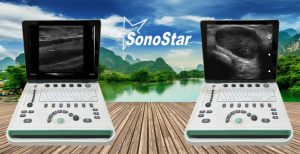Portable Color Doppler Ultrasound in Breast Surgery: A Revolutionary Tool

Contact:
SonoWave Technologies
Mobile: 01717811312
Breast surgery encompasses a wide range of procedures, from diagnostic interventions like biopsies to therapeutic surgeries for benign or malignant conditions. Portable color Doppler ultrasound has emerged as an invaluable asset for breast surgeons, enhancing diagnostic accuracy, guiding interventions, and improving post-operative care. This article provides an in-depth look at the applications, benefits, and transformative impact of portable color Doppler ultrasound in breast surgery.
Understanding Portable Color Doppler Ultrasound
Portable color Doppler ultrasound combines traditional grayscale imaging with Doppler technology, allowing clinicians to visualize breast tissues and evaluate blood flow in real-time. Key features include:
- Grayscale Imaging: Provides detailed anatomical images for structural assessment.
- Color Doppler: Highlights blood flow patterns, helping to differentiate between benign and malignant lesions.
- Power Doppler: Detects low-velocity blood flow, particularly useful in small or poorly vascularized lesions.
- Spectral Doppler: Measures blood flow velocity, offering additional insights into vascular abnormalities.
Its portability and ease of use make it ideal for point-of-care applications in clinics, operating rooms, and remote settings.
Applications of Portable Color Doppler Ultrasound for Breast Surgeons
1. Diagnostic Applications
1.1 Differentiating Between Benign and Malignant Lesions
- Blood Flow Patterns: Malignant tumors typically show increased vascularity with irregular blood flow, while benign lesions have minimal or organized vascularity.
- Doppler Signals: Helps identify suspicious lesions requiring biopsy.
1.2 Evaluating Palpable Lumps
- Distinguishes solid masses from cystic structures.
- Identifies fibroadenomas, cysts, or abscesses.
1.3 Assessing Breast Infections
- Detects abscess formation in mastitis.
- Guides drainage procedures by visualizing the extent of infection.
1.4 Screening High-Risk Patients
- Supplements mammography, especially in dense breast tissues where mammograms may be less effective.
2. Procedural Guidance
2.1 Ultrasound-Guided Biopsies
Portable Doppler ultrasound ensures precise targeting of suspicious lesions during core needle or vacuum-assisted biopsies.
2.2 Wire Localization for Surgery
Helps localize non-palpable tumors before lumpectomy, improving surgical precision.
2.3 Aspiration of Cysts or Abscesses
Guides needle placement for cyst aspirations or abscess drainage, minimizing complications.
2.4 Sentinel Lymph Node Biopsy (SLNB)
Enhances the identification of sentinel lymph nodes by evaluating their vascularity and guiding the injection of tracers.
3. Pre-Operative Planning
- Tumor Mapping: Defines the exact size, shape, and location of the tumor.
- Vascular Mapping: Evaluates blood supply to the lesion, helping in surgical planning.
- Multifocal Disease: Identifies additional lesions that may not be detected on mammography.
4. Intra-Operative Applications
4.1 Real-Time Tumor Localization
- Portable ultrasound enables real-time visualization of tumors during lumpectomy, ensuring complete excision while preserving healthy tissue.
4.2 Margin Assessment
- Detects residual tumor tissue, reducing the need for re-excision.
4.3 Assessment of Axillary Nodes
- Evaluates lymph nodes during axillary dissection or sentinel lymph node biopsy.
5. Post-Operative Care and Monitoring
5.1 Detecting Post-Surgical Complications
- Identifies hematomas, seromas, or abscesses after surgery.
- Monitors vascular compromise in reconstructive flaps.
5.2 Follow-Up of Breast Implants
- Assesses implant integrity and detects complications like rupture or capsular contracture.
5.3 Monitoring Tumor Recurrence
- Evaluates the surgical site for signs of local recurrence in high-risk patients.
Benefits of Portable Color Doppler Ultrasound for Breast Surgeons
- Enhanced Diagnostic Accuracy: Combines structural and vascular information to improve lesion characterization.
- Non-Invasive: Provides a radiation-free alternative to traditional imaging modalities.
- Real-Time Imaging: Enables dynamic assessment during patient examination.
- Cost-Effective: Reduces the need for more expensive diagnostic tests like MRI.
- Point-of-Care Use: Facilitates immediate decision-making in outpatient settings or during surgery.
- Improved Patient Comfort: Eliminates the need for repeated imaging appointments.
Advancements in Portable Ultrasound Technology
- Wireless Connectivity: Enables real-time image sharing and telemedicine applications.
- Artificial Intelligence (AI): Assists in lesion characterization and improves diagnostic accuracy.
- Compact Probes: Enhances maneuverability for breast imaging.
- Improved Battery Life: Supports extended use in busy clinical settings.
Future of Portable Doppler Ultrasound in Breast Surgery
The integration of advanced technologies, such as AI-powered diagnostic assistance and 5G connectivity, will further expand the utility of portable Doppler ultrasound. Its role in precision medicine, particularly in tailoring surgical approaches and post-operative care, will continue to grow.
Conclusion
Portable color Doppler ultrasound has become an indispensable tool for breast surgeons, offering unparalleled diagnostic and procedural advantages. Its versatility spans the entire continuum of breast surgery, from diagnosis and intervention to post-operative care and surveillance. As technology advances, its role in improving patient outcomes and advancing breast surgery will only strengthen.
This comprehensive guide underscores the transformative potential of portable Doppler ultrasound, paving the way for more efficient, accurate, and patient-centered breast surgery practices.
